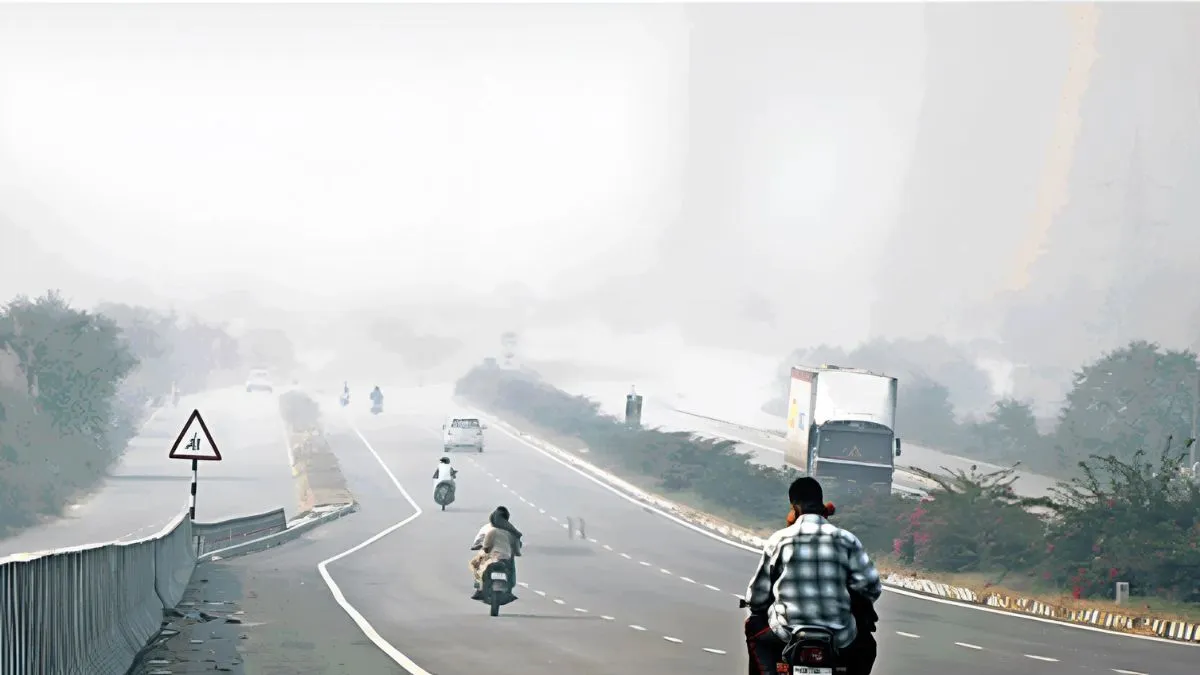- By Akansha Pandey
- Thu, 23 Oct 2025 02:15 PM (IST)
- Source:JND
Pollution, which began rising in the state before the festivals, has now taken a serious turn. Reports from the Central Pollution Control Board (CPCB) from October 19 to 22, 2025, make it clear that the state's air is continuously becoming more toxic. This time, stubble-burning incidents have decreased, but pollution has risen contrary to expectations.
The situation is such that nine of the state's districts have reached the 'Red Zone', including Ambala, Fatehabad, Yamunanagar, Bhiwani, Charkhi Dadri, Dharuhera, Jind, Narnaul, and Rohtak.
According to government data, stubble-burning cases have decreased by up to 97 percent this time compared to previous years. Despite this, the state's average AQI has risen from 180 to 320 in the last four days—an increase of nearly 78 percent. In districts where stubble was not burned, industrial smoke, vehicle emissions, and low wind speed have worsened the situation.
Experts say the level of fine particulate matter (PM 2.5) in the air has risen several times above the normal limit. Following Diwali, efforts to control pollution are proving ineffective. In this scenario, it is possible that Stage 3 restrictions of the Graded Response Action Plan (GRAP) will need to be implemented in several districts of the state.
Air quality in the state continuously deteriorated during the third week of October, but this decline was not uniform. An analysis of CPCB reports from October 19 to 22 makes it clear that the southern and central regions of the state were the most affected, while the northern and western regions were relatively less impacted.
Situation Worsening In Bhiwani-Yamunanagar
The five districts in the state facing the most serious situation are Ambala, Fatehabad, Yamunanagar, Bhiwani, and Panipat. Between October 19 and 22, 2025, air quality in these districts fell continuously.
Ambala's AQI rose from 147 to 312, Fatehabad's from 147 to 305, Yamunanagar's from 102 to 320, Bhiwani's from 33 to 331, and Panipat's from 118 to 259. In Bhiwani, the pollution level increased tenfold in four days. A 203 per cent increase was recorded in Yamunanagar. Additionally, Panipat also saw an average increase of 119 per cent.
Relief: Pollution Decreased by up to 25 per cent in Jind and Bahadurgarh
Between October 21 and 4 PM on October 22, the most significant improvement in air quality was recorded in Jind, Bahadurgarh, Gurugram, Faridabad, and Narnaul. In these districts, pollution decreased by an average of 20 to 27 percent.
Jind showed the biggest improvement, with its AQI dropping from 421 to 319. Bahadurgarh registered a 99-point decrease, and Gurugram recorded an approximately 24 percent improvement. The air in Faridabad and Narnaul also cleared to some extent. According to experts, this improvement was possible due to increased wind speed and a reduction in local industrial activities. However, despite this relief, the air quality still remains in the 'Very Poor' category.
Central Haryana (Jind, Rohtak, Karnal, Sonipat, Kaithal): AQI Increased by 69 per cent
The situation in this region was concerning. Jind's AQI reached 421, which was the worst level in the entire country in real-time. Rohtak and Sonipat also consistently recorded an AQI above 300. The situation in Karnal and Kaithal was slightly better but could not rise above the 'Poor' category. This region was most affected by stubble-burning incidents and vehicular smoke. In Jind, stubble was burned at 15 locations on Diwali.
West Haryana (Hisar, Fatehabad, Sirsa, Bhiwani, Charkhi Dadri): AQI Increased by 166 per cent
Here, pollution levels ranged from 'Moderate' to 'Very Poor'. The air quality in Bhiwani (331) and Fatehabad (305) deteriorated on October 22. The situation in Hisar and Sirsa was slightly more stable. West Haryana's pollution is primarily linked to stubble burning and industrial emissions. Mining in the crusher zones in Bhiwani and Charkhi Dadri is also considered a responsible factor.
Also Read: Lucknow Awadh Crossing Underpass: Work In Full Swing To Ease Agra-Delhi Traffic
North Haryana (Ambala, Yamunanagar, Kurukshetra, Panchkula): AQI Increased by 116 per cent
This region was in a comparatively better situation, although a decline was also recorded here by the end of the week. On October 22, the AQI in Ambala (312) and Yamunanagar (320) reached the 'Very Poor' category.
Ambala: Air quality in Ambala, previously a relatively clean area, worsened by almost double in four days, reaching the 'Very Poor' category by October 22.
Fatehabad: Continuous decline was seen due to stubble burning and industrial emissions. An increase of more than 100 points in the AQI was recorded in four days.
Yamunanagar: Despite being in a hilly region, the district is now in the grip of pollution. By the end of the week, its air quality fell into the 'Very Poor' category.
Bhiwani: The AQI increased almost tenfold in the last four days, making it the district with the fastest decline in air quality.
Also Read: Gorakhpur AIIMS: SE Manisha Tiwari's Appointment Questioned Over Experience
Panipat: An increase in AQI was recorded on all four consecutive days. The pollution level here continuously moved from 'Poor' to 'Very Poor'.
Dharuhera And Narnaul: Industrial areas like these also saw minor relief, but the air remains in the 'Very Poor' category. After Jind, Dharuhera was ranked at the top nationally for high pollution.

